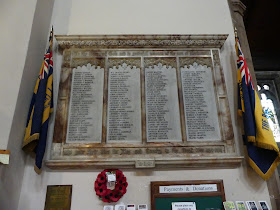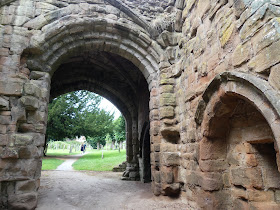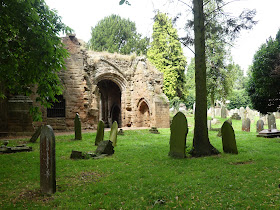A record of wildlife in my garden and various trips to the Warwickshire countryside and occasionally further afield.
Tuesday, 23 July 2019
St Nicholas Church and the Abbey of St Mary Kenilworth
After leaving the Castle I drove to Abbey Fields and the church of St Nicholas and the ruins of the Abbey. Apologies in advance as I have got rather carried away with photos! I should really have given the Abbey a separate post but with the holiday and days out I am still behind with posts and trying to catch up.
A church existed in Kenilworth before St Nicholas's was built although the exact location is not known although there is some evidence hat it may have been in what is now a cottage on Castle Green opposite the castle - I will try and get a photo in the future as I am sure I will be returning to Kenilworth.
It is believed the present day church was founded around 1285 but there is no definite date for the building of the church although it was some time in the 13th century. It is close to the abbey and therefore it is likely that the land was provided by the priory. The church is built of local red sandstone. In the 14th century the church was extended by the addition of a south aisle, a north aisle and the north-west porch. In the mid 1800's the church was extended again and a restoration took place under a Reverend Bickmore.
This was a lovely bench to sit while I took a call from B and E and watched bees on the hebe.
The West door has been described by Pevsner as "the most sumptuous Norman door in Warwickshire". It was constructed in the 16th century using Norman stonework from several doors in the abbey. It has been suggested that Robert Dudley wanted the door to be installed so Queen Elizabeth I could enter the church through it when she visited. She did in fact attend one or two services at the church during her stay.
Beakheads are Romanesque carvings of mythical birds' and beasts' heads with pointed beaks or tongues.
Some parts of the church were quite dark and I struggled to get a decent photo of the font which dates from 1664 although the base is Norman from the original font. The font cover is more recent and was designed by a Hugh Ledbrook from Kenilworth in memory of his brother William.
I believe this stained glass window may be by John Hardman and Company, Birmingham and is Victorian.
The Caroline Gresley memorial which dates from 1817 and is the work of Westmacott. Her family lived at "The Hall" nearby which has now been turned into flats. The most
famous resident of the hall was possibly William Pears from "Pear's Soap".
The pulpit carved with saints dates from 1911 and the lectern from 1921. The carvings were lovely but again I struggled to get decent photos and have tried to edit them slightly to make them lighter.
My focus on stained glass windows has changed in the last year especially since having my own bridge camera where I can zoom in. Every week between 1 and 2 on Wednesdays there is a fun event on Twitter called #AnimalsinChurches which has a different theme each week. So consequently whenever I visit a church I am searching for wildlife in stained glass, carvings, tombs etc.
This Pig of Lead was found in 1888 and has Henrvy VIII's commissioner's stamp on it. A "pig" or "fother" weighed over half a ton and the item is made from lead melted from the dismantled abbey's roof at the Dissolution.
The Sedilia date to the "Decorated" period but it is not known whether they were made for the church or the abbey. The Piscina is also in the "Decorated" style but dates from the Victorian restoration.
The reredos shows Christ and the Last Supper.
John from The Stray Rambler's blog (see My Blog List on the right) visited Kenilworth Castle and church last year and it was his post on the church which made me want to visit as there are two rather lovely windows. Unfortunately I "forgot" about this one which shows a teddy bear, a doll and a book with elephants and didn't get a very good photo - the teddy and rabbit are rather heavily cropped! To see John's blog post please see here where there are much better photos of this window.
John Bird memorial installed 1772.
The South Transept window which was once the East Window shows "achievements" of the nobility associated with Kenilworth including Geoffrey de Clinton and the Earl Clarendon - the first and last owners of the castle. Again in this window there are many tiny lions ideal for #AnimalsinChurchesHour.
Agnus Dei in the centre and
in this stained glass we can see a pelican and young. Pelicans are often depicted in Christian art as they were once believed to pierce their breasts and feed their young with blood and it thus became a Christian symbol of Christ sacrificing himself for man.
This was my favourite window and one I was determined to find after seeing the Stray Rambler's visit to the church.
There are some delighful images of robin, frog, rabbit, deer, dragonfly squirrel and a blue bird in this window.
Behind the lectern is a "Squint" or hagioscope which would have allowed someone on the west side to see what was occurring at the altar during mass. When the host and chalice were elevated by the priest the person looking through the squint would ring the sacring bell.
The First World War memorial was unveiled and dedicated by the then Vicar the Reverend Joseph William Dennis on 1st February 1920 and it commemorates the deaths of 120 people.
In the porch there is a display showing wildlife to be found in the churchyard and on 25th May the church held an Eco Church Open Day where plans were explained for the management of the churchyard and a bioblitz survey took place.
After walking through the churchyard I went to look at some of the remains of the Priory of St Mary now referred to as The Abbey which was founded in 1119 by Geoffrey de Clinton, Chamberlain and Treasurer to Henry I.
2019 is the 900th anniversary of the founding of what was once one of the most prestigious Augustinian houses in the Midlands. The Priory created gardens and a series of pools to provide water power for the mills and fish and waterfowl for the table. Over the years the Priory became one of the richest landowners in Warwickshire and in 1447 the Pope, recognising its importance, raised it to the status of an abbey. At its height the Abbey building would have contained cloisters, a barn, storehouse, a refectory, a dorter (dormitory), chapter house, infirmary and an Abbey church with a separate bell tower. The abbey closed in 1538 during Henry VIII's Dissolution of the Monasteries and much of the abbey stone was used as a building stone including alterations at the castle. The passage of time meant that many of the ruins were lost although two of the 14th century abbey buildings escaped most of the destruction and still stand today. These are the "Tantara" gatehouse and the "Barn" which is now a museum (not open when I visited). Archaeological excavations took place in 1840 and 1890 and some of the abbey foundations were revealed. There were further excavations in 1922 and in 1966/67 the decision was made to rebury most of them in the hope they would be preserved.
The Gatehouse
The Barn - now a museum
Scratch or mass dial
The churchyard has now spilled over into the abbey grounds and thus the ruins of the nave and transepts of the abbey church and the abbey gatehouse are within the churchyard. The abbey nave is now a Garden of Rest for cremated remains.
The church of St Nicholas
After leaving the church I drove into the town centre hoping to visit an independent bookshop. Sadly, the one way system defeated me and I gave up! In the evening D and I went for a meal at our favourite pub The Bear at Berkswell where we had Battered Halloumi, chips and peas, me a cheesecake and D choc fudge cake - all of which were delicious :)
All photos taken by me with the Panasonic Lumix FZ330 bridge camera (thankfully now without the retro filter in operation!!)
Reference: Information Board at The Abbey
"The Parish Church of St Nicholas, Kenilworth A Guide to the Building and its History" First published 2008
"A Guide to the Historic Town of Kenilworth" Kenilworth History and Archaelogy Society in conjuction with Kenilworth Town Council




























































































It's a lovely church and I like the windows expecially the wildlife ones with rabbits and squirrels and the old tiles too. Looks like you had a lovley day out and your evening meal sounds very tasty:)
ReplyDeleteI have been setting up a new laptop, so need to go back as I may have missed an entry. I do like the west door, there's a lot of detail in the carving making it special. Is the stone a soft stone such as limestone? It looks quite eroded. The stained glass windows are quite something, aren't they?
ReplyDeleteRosie - Thank you - I was determined to find the wildlife window - I thought I'd missed it but it was the last one! The Bear is consistently good with the food and the service and it is a lovely olde worlde pub with a good choice on the menu. D's starter looked good stilton stuffed mushrooms! :)
ReplyDeleteRustic Pumpkin - Thankyou - hope you are getting there with your new laptop :) Sorry I am posting so many posts atm - as I know it is so hard to keep up and some of my posts are long! Yes, I think sandstone is soft and weathers easily. I loved the stained glass there particularly the heraldry and wild life ones. Luckily I had more time than usual being on my own hence too many photos!!!
Yes, I meant to say sandstone, not limestone, silly me! Our cathedral is built from Caerbwdi stone which is purple and grey green in colour. It suffers badly with erosion too. Glad you had some proper me time for a change. I had not missed one post.
ReplyDeleteRustic Pumpkin - To be honest I will be glad when I have caught up with posts! Not happy having to post so regularly! Interesting about your cathedral with a different stone suffering badly from erosion too. But there is something good about the way they used local stone centuries ago.
ReplyDeleteWhat a super post - I felt like I'd been there with you! I loved the wildlife in the stained glass window too. It's a shame it's too far for a day out for us - we will have to have a night away some time this year and go exploring.
ReplyDeleteBovey Belle - Thank you. Iam afraid it was a bit top heavy on photos and over long! There is a lot to see in that area if you do decide to have a night away. The window I finally found at the end was so lovely :)
ReplyDeleteJohn Scurr - Thanks so much. I found your post so inspiring and it is the main reason why I so much wanted to visit the church! Holidays can be tiring - I do so much research before we go and then have to persuade the family to go to at least some of the places I have found! For once I had more time at Kenilworth church as I was on my own (I still missed things though!). Also for me Kenilworth is fairly local :)
ReplyDeleteThis church and surroundings look delightful. There are so many things of interest to me :-)
ReplyDeleteCherryPie - Thank you - it was an interesting location :)
ReplyDelete